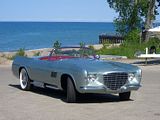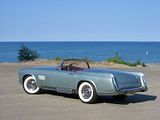|
Throughout his career, Exner expressed a fondness for certain classic elements of automobile design, particularly for those that highlighted the mechanical functionality of a car. He liked round, open wheel arches; he liked upright grilles; and he especially liked fast, powerful cars. So by the early to mid-1950s, after Exner became Chryslerís first director of styling and when he felt it was finally time to design a car for himself, he didnít design just another sedan or luxury car; instead, he designed a two-seat convertible sports car. As Peter Grist wrote in his biography of the designer, Virgil Exner: Visioneer, Exner wanted ďa car that embodied everything that he wanted to see in a classic automobile; sports, thoroughbred styling and power to match.Ē With help from designer Maurice Baldwin, Exner came up with a logical, though slightly larger, competitor to Chevroletís Corvette and Fordís Thunderbird. Sitting on a 105-inch wheelbase (in 1955, both Corvette and Thunderbird rode 102-inch wheelbases) and coming in at 182 inches total length (compared to 167 inches for Corvette and 175 inches for Thunderbird), the Falcon used integrated body and frame construction as well as a 276-cu.in. Hemi V-8 backed by a PowerFlite automatic transmission. As with other Exner idea cars, Ghia built the Falcon for Chrysler. According to Grist, however, Exner envisioned the Falcon as more than an idea car. It borrowed heavily from the Chrysler parts bin and didnít require any advanced production techniques, so why not develop it as a production car, he reasoned. But Chryslerís engineering staff, with which Exner fought incessantly, blocked the Falcon from becoming a reality, noting that the company already had a couple of performance vehicles in the Chrysler 300-series cars and Dodge D-500; why would it need another? Nevertheless, more than one Falcon was built; just how many is up for debate. The original one, finished in black, went to Exner, who competed with it at SCCA races, but a number of sources have pointed to a May 27, 1954, letter from Ghiaís Luigi Segre to Chryslerís C.B. Thomas mentioning two different Falcons (designated A-488 and called ďChrysler Sports RoadsterĒ) as well as a near-identical De Soto Sports Roadster (designated A-489). Exnerís black Falcon has gone missing and wasnít recorded as destroyed, and the third one Ė reportedly painted red Ė was apparently never photographed, but the second one, a light blue example, wound up in Joe Bortzís collection in 1987, and will make its way to Amelia in March 2014. |
|



